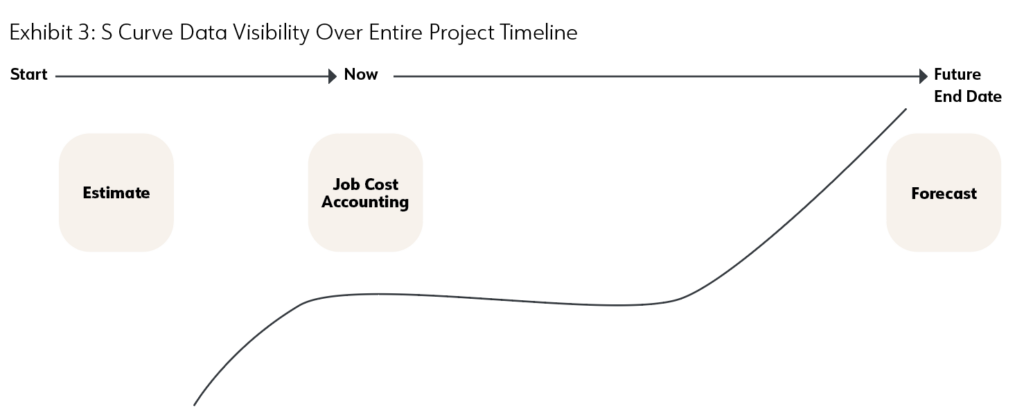A construction company faces three primary visibility challenges in predicting the timing of job margin: understanding how work backlog translates into margin, determining if a project is behind in dollars, and having forward visibility into how gross margin will end up for the year.
To help businesses overcome these obstacles, S curve forecasting is a powerful tool that provides margin visibility, timing, and control. This article explores the concepts of S curve forecasting, provides real-life examples that illustrate the concepts, and discusses the benefits and features to look for in an S curve solution.
S Curve Forecasting — A Powerful Tool for Margin Visibility, Timing & Control
S curves are named as such because monthly project cost and revenue tend to be low (flat) in the early stages of a project, steepen during the middle as costs increase, and flatten again at the end. This flat, steep, flat shape manifests as an “S.”
S curve tools provide the ability to plot a project’s planned cost, revenue, and margin compared to the actual costs/revenue using a monthly or milestone-based schedule format.
More complex, longer duration projects will typically use the milestone format to provide more granularity and better accuracy. S curves provide powerful visualization capabilities, coupled with the ability to make dynamic adjustments to dates, percent complete, and cost/revenue, while seeing the results instantly for better visibility of project timing required to achieve financial performance.
Real-Life Example: The Construction of a Shopping Mall
To better understand the importance of S curve forecasting, let’s consider a real-life example. A construction company has been contracted to build a shopping mall. The project has a budget of $50 million and is expected to take 24 months to complete. The company’s project manager (PM) needs to ensure that the project schedule and budget stay on track. They decide to use S curve forecasting to monitor the project’s progress and make informed decisions based on the data.
S Curve Forecasting in Action
The PM sets up a milestone-based S curve for the shopping mall project, breaking down the project into various phases, such as site preparation, foundation, structural work, and finishing. Each phase is associated with specific costs, revenues, and scheduled completion dates. As the project progresses, the PM uses the S curve to visualize the project’s planned cost, revenue, and margin vs. actuals, allowing them to make necessary adjustments and predict future outcomes.
Integrating S Curve Forecasting With Key Systems
In this example, the construction company integrates its S curve forecasting tool with its accounting and forecasting systems. This integration ensures that labor, material, equipment, and other costs are automatically synchronized with the S curve actuals by month and milestone. Additionally, weekly or monthly PM forecasts can be synced to update projected costs, hours, and units of completion. This integration not only increases accuracy, but it also eliminates the need for costly data reentry.
Tracking Milestones for Deeper Insight
Milestone-based S curves are more detailed than simple monthly S curves. Breaking down an S curve project cost and revenue into phases (milestone activities) provides a greater degree of accuracy for more complex projects. This helps ensure milestone events are accurately accounted for and billed as cost events happen.
Milestone S Curve Benefits
- Detailed project view provides a better alignment between cost, revenue, and schedule.
- The ability to associate milestone events with the proper billing month.
- Templates can be used to speed up the setup of new S curve milestone schedules.
- The milestone event day/month can automatically populate using project duration days.
- Ability to link to Gantt schedules to populate S curve templates.
Milestone-based S curves offer numerous benefits that can help construction companies better manage their projects. These benefits allow for more precise project management, ultimately leading to improved outcomes and greater profitability.
Better Alignment Between Cost, Revenue & Schedule
By breaking down a project into distinct milestone activities, PMs can more effectively monitor progress and make necessary adjustments. For example, if a construction project has separate milestones for foundation work, framing, and roofing, PMs can identify cost overruns or delays in each phase and take corrective action promptly.
Accurate Billing & Cash Flow Management
Associating milestone events with the proper billing month ensures that invoices accurately reflect the work completed during that period. This helps maintain a healthy cash flow for the business. For instance, if a project milestone, such as completing the foundation, is associated with a specific billing month, the company can invoice the client accordingly and maintain a steady stream of revenue.
Efficient Setup of New S Curve Milestone Schedules
Using templates can significantly speed up the process of setting up new milestone schedules for similar projects. For example, if a construction company frequently builds apartment complexes, it can use a predefined template with common milestones like site preparation, structural work, and finishing to quickly create a new project schedule.
Automatic Population of Milestone Event Days & Months
By autopopulating milestone event days and months based on the project’s overall duration, PMs can save time. For instance, if a project is scheduled to take 12 months and has evenly distributed milestones, then the system can automatically calculate the expected completion dates for each milestone. If the project end date is changed, then the remaining period S curve milestone amounts and completion dates are recalculated and prorated over additional time.
Seamless Integration With Gantt Schedules
The ability to link milestone-based S curves to Gantt schedules allows PMs to visualize the project’s overall timeline alongside its financial performance. This integration can help identify bottlenecks, potential delays, and areas where resources may need to be reallocated.
Integration With Key Systems: Bringing It All Together
For construction CFOs and PMs, selecting an S curve forecasting solution that integrates with key systems like accounting and forecasting is essential. This integration not only increases accuracy, but it also eliminates the need for costly duplicate data entry, ultimately saving time and resources.
- Job Cost Accounting (ERP) system: Automatically synchronizes labor, material, equipment, and other costs to update S curve actuals by month and milestone.
- PM forecast: Weekly and monthly PM forecasts can be synced to update projected cost, hours, and units of completion.
Traditionally, these source systems provide information at a point in time (e.g., cost to date, forecasted cost at completion, cost to complete). S curve exposes this data over a time horizon.
The Result: Complete Visibility & Control Over Project Margins
Effective S curve forecasting requires some effort to set up and maintain. Each month the amount of billings and costs incurred will be different from the S curve calculated amounts. Those differences must be allocated over the remaining months, further refining future visibility.
Evaluating S Curve Solutions: Important Features
The benefits far outweigh the costs. A properly maintained S curve schedule provides real-time visibility into remaining durations, billings, costs, and margins in easy-to-use dashboards. This helps identify future cash flow constraint points and provides better project financial control.
EVALUATING S CURVE SOLUTIONS: IMPORTANT FEATURES
Building on the basics of S curve forecasting, the following key features can greatly enhance the power and usability of your solution:
- Seamless integration with Job Cost Accounting (ERP) systems: Choose an S curve solution that automatically synchronizes labor, material, equipment, and other costs to update actuals by month and milestone. This feature ensures that your financial data is always current and accurate, allowing for better project management and decision-making.
- Compatibility with PM forecasts: A robust S curve solution should sync with weekly or monthly PM forecasts, updating projected costs, hours, and units of completion. This helps PMs stay on top of their projects’ financial performance and make informed decisions.
- Monthly or milestone-based S curve forecasting: Opt for a solution that accommodates both simple and complex projects, offering flexibility in how you manage your construction business.
- S curve templates: To streamline project setup, look for a solution that offers S curve templates for different kinds of projects (e.g., schools, hospitals). These templates can be copied and customized to suit new projects with similar milestones, saving valuable time and effort.
- Auto load S curve from historical jobs: With a powerful S curve solution, you should be able to create an S curve based on completed projects, leveraging past data to inform future decision-making.
- Auto allocation feature: Find a solution that can automatically spread remaining contract revenue, cost, and days back to specific milestone durations based on historical percentages. Ensure that auto-generated data can be overridden to adapt to unique project conditions when necessary.
- Accounting and forecasting integration: Choose a solution that integrates seamlessly with your existing accounting and PM forecasting systems, eliminating dual entry, and increasing accuracy.
- Build S curve information at the cost type level: Choose a solution that enables you to build actual and forecasted costs at the cost type level (e.g., labor, materials, equipment). This granular approach provides more accurate financial data and improved project management capabilities.
By selecting an S curve forecasting construction CFOs and PMs can gain complete visibility and control over project margins. As a result, you’ll be better equipped to identify future cash flow constraints, optimize resource allocation, and improve the overall financial performance of a project.
OTHER OPTIONS FOR S CURVES
S curve forecasting can also be done in a company’s project scheduling software. However, a full-time cost engineer is needed to break down accounting costs back into detailed work breakdown structure (WBS) tasks and a full-time schedule update resource to maintain it. This article outlines a solution for most of the contractors that don’t have that luxury.
Challenges with scheduling software include:
• Scheduling level WBS structures and tasks are more detailed than cost code/ phase breakdowns in accounting job cost.
• Taking job costs from the accounting systems and mapping it back to the detailed WBS is often impossible.
• Integration with the source data is critical and few “integrations” available to map accounting job cost back to the scheduling software. Again, there is significant low-value time spent to rekey and reconcile the data before a PM can analyze the data; integrations let construction financial professionals focus on analysis.
Conclusion
Job cost accounting systems provide the current state of job costs to date and billings to date. Job forecasts provide the vision of final cost at completion based on insights of project management. Critically, S curves leverage those factors over a time horizon to show a true windshield view of project financial health — displaying both the journey and the destination.
Be aware, S curves are a game of horseshoes, not darts. Start the S curve process at a high level, because too much detail will choke the process, delaying constraint identification and limiting time to respond. Used effectively, milestone-based S curve analysis provides a powerful tool for construction companies to gain deeper insight into their projects’ and overall company financial performance.
Learn more about Anterra S Curve forecasting here.



